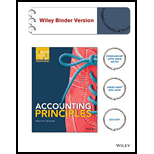
Concept explainers
(a)
(1)
Periodic Inventory System: It is a system in which the inventory is updated in the accounting records on a periodic basis such as at the end of each month, quarter or year. In other words, it is an accounting method which is used to determine the amount of inventory at the end of each accounting period.
Inventory cost flow: It refers to the flow (movement) of inventory when it is purchased or sell by the business organization.
The various inventory cost flow methods are:
- First-in, first-out (FIFO)
- Last in, first-out (LIFO)
- Average-cost
Specific identification method: In the identification method of inventory costing, business organization needs to record the each item of inventory at its actual cost.
Income Statement: The income statement is that financial statement which shows the net income (or loss) of the Company. In the income statement, to calculate the net income, all expenses incurred by the Company are deducted from the total revenue of the Company.
To determine: Partial income statement through gross profit and value of ending inventory reported in
(2)
FIFO method: In FIFO method, those goods are sold first which are purchased first by the business organization.
To determine: Partial income statement through gross profit and value of ending inventory reported in balance sheet under FIFO
(3)
LIFO method: In LIFO method, those goods are sold first which are purchased in last by the business organization.
To determine: Partial income statement through gross profit and value of ending inventory reported in balance sheet under LIFO.
(b)
The method used by companies to justify price increases and the method to support an argument to increase prices.
Want to see the full answer?
Check out a sample textbook solution
Chapter 6 Solutions
Accounting Principles 12E WileyPLUS with Loose-Leaf Print Companion with WileyPLUS Leanring Space Card Set
- Hello tutor need assistance but not chatarrow_forwardThis question is acc no aiarrow_forwardA company currently has $54 million in sales, $23 million in current assets, $43 million in fixed assets, and $15 million in accounts payable. The fixed assets are currently operated with full capacity and will change proportionally with the sales growth. Sales are projected to be $85 million, current assets are projected to be $32.2 million, and accounts payable are projected to be $21.0 million. What are fixed assets projected to be, given this information?arrow_forward
- Brock's Pest Control, Inc. has sales of $945,000, costs of $410,000, depreciation expense of $67,000, interest expense of $45,000, and a tax rate of 23%. The firm just paid out $120,000 in cash dividends and has 100,000 shares of common stock outstanding. a. What is the Earnings Per Share (EPS)? b. What is the Dividends Per Share (DPS)? HELParrow_forwardAzure Apparel has received a special order forarrow_forwarddon't use chatgpt tool.arrow_forward

 AccountingAccountingISBN:9781337272094Author:WARREN, Carl S., Reeve, James M., Duchac, Jonathan E.Publisher:Cengage Learning,
AccountingAccountingISBN:9781337272094Author:WARREN, Carl S., Reeve, James M., Duchac, Jonathan E.Publisher:Cengage Learning, Accounting Information SystemsAccountingISBN:9781337619202Author:Hall, James A.Publisher:Cengage Learning,
Accounting Information SystemsAccountingISBN:9781337619202Author:Hall, James A.Publisher:Cengage Learning, Horngren's Cost Accounting: A Managerial Emphasis...AccountingISBN:9780134475585Author:Srikant M. Datar, Madhav V. RajanPublisher:PEARSON
Horngren's Cost Accounting: A Managerial Emphasis...AccountingISBN:9780134475585Author:Srikant M. Datar, Madhav V. RajanPublisher:PEARSON Intermediate AccountingAccountingISBN:9781259722660Author:J. David Spiceland, Mark W. Nelson, Wayne M ThomasPublisher:McGraw-Hill Education
Intermediate AccountingAccountingISBN:9781259722660Author:J. David Spiceland, Mark W. Nelson, Wayne M ThomasPublisher:McGraw-Hill Education Financial and Managerial AccountingAccountingISBN:9781259726705Author:John J Wild, Ken W. Shaw, Barbara Chiappetta Fundamental Accounting PrinciplesPublisher:McGraw-Hill Education
Financial and Managerial AccountingAccountingISBN:9781259726705Author:John J Wild, Ken W. Shaw, Barbara Chiappetta Fundamental Accounting PrinciplesPublisher:McGraw-Hill Education





